Maryland
| |
|
Accokeek |
Maryland |
USA |
Armillary Sphere |
Dial 118 |
| Copper armillary dial 18 inches diameter. Two main rings are square1/2 inch tubing. Other parts of armillary are made of flat copper, about 3/4 inch wide. Has Roman numerals. Probably built by Ferguson family and installed in the 1920's. The dial base is cast cement, partly fluted, about 3-1/2 foot high, round at top, square at bottom. |
| |
| |
 |
Addison |
Texas |
USA |
Sun Alignment |
Dial 1089 |
| This is a sun alignment arch about 23 feet (7m) high and 650 feet (20m) in length and 5 foot (1.5m) wide, It is made of Corten steel, a metal whose surface oxidizes quickly, leaving a rusty chocolate color that provides a textured surface. The archAt the top of the arch are keystone wedges that funnel sunlight on the equinox at local solar noon onto a steel sphere on the ground below. The original model for the arch was made in bronze in 1974 and titled “Rainbow arch restructured”. |
| |
| |
 |
Albany |
New York |
USA |
Vertical Dial |
Dial 497 |
| A beautiful and well preserved vertical dial 40 x 40 inches. The sundial is on the southerly facing wall of Albany City Hall's 202 foot carillon tower, a building on the National Historic Register. The dial is marked with lines every 15 minutes; the hour lines are marked in roman numerals extending from XII in the morning to XII at night. Although the dial is in excellent condition, the gnomon is slightly bent. There is a small "signature" on the lower boarder of the brass plate, "Haight and Clark, Albany NY". Side note: The tower houses the first municipal carillon in the US (1927). |
| |
| |
 |
Albuquerque |
New Mexico |
USA |
Vertical Dial |
Dial 921 |
| This painted vertical dial is 10 x 11 feet, covering a vast expanse of south facing wall. The dial has a strong New Mexico theme using bright colors, and many personal elements. There is a road runner, hot air balloon, a lunar footprint (centered at 2:18 (clock time) on July 20th 1969, the minute they landed). There is a red, white & blue star at the 11th hour of the 11th day of the 11th month for Veterans Day. In the night exposure of the sundial the star Polaris is just above the gnomon, as it should always be. All the little embedded details in the sundial are explained on the ‘Details’ tab of the website link below. |
| |
| |
 |
Albuquerque |
New Mexico |
USA |
Vertical Dial |
Dial 567 |
| A vertical "Icarus Sundial" of bronze, copper and ceramic 86 inch high x 48 inch wide on a 30 inch high pedestal in front of the Explora science museum. The gnomon depicts Icarus falling; the back side depicts Icarus ascending toward the sun. The pedestal is placed within a 20 foot concrete circle showing a labyrinth defined by a sandblasted path of feathers. |
| |
| |
 |
Albuquerque |
New Mexico |
USA |
Horizontal Dial |
Dial 669 |
| A 36 inch diameter brass and copper horizontal sundial with a gnomon depicting a bird standing and a bird in flight. The bird motif reminds of "The Bird of Time has but a little way to fly--and Lo! the bird is on the Wing" by Omar Khayyam.
The gnomon is buttressed for strength and includes a brass ball at the top as a safety feature in light of a nearby middle school. |
| |
| |
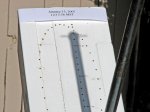 |
Albuquerque |
New Mexico |
USA |
Sun Alignment |
Dial 723 |
| An 8x36 inch polar noon meridian dial of wood and steel pipe. The dial face is inclined at the latitude angle and the shadow-casting 36-inch gnomon pole is perpendicular to the dial face, pointing at the local meridian on the celestial equator. The gnomon pole shadow shows the declination of the sun, with the shadow extending below the gnomon in spring and summer, and above the gnomon in fall and winter. Short rods at the tip of the gnomon cast a cross-shaped shadow on the dial face, marking the date on the nail head analemma on the dial face. At local noon the gnomon shadow is vertical; the face and gnomon size are selected to allow the shadow to always fall on the dial face at noon throughout the year. On the equinoxes, the cross shadow bisects the gnomon base.
This dial is on private property but may be seen from the public sidewalk. For closer inspection, the owner may be contacted. |
| |
| |
 |
Alburquerque |
New Mexico |
USA |
Horizontal Dial |
Dial 854 |
| This was a unique horizontal sundial designed for the Nob Hill Main Street program, where the sundial anchored the southeast corner of the Nob Hill Community Garden. Created several years ago by Mike Heighway and Mira Rose, Mike explained, "The purpose of the Nob Hill Sundial is to act as an interactive gardener’s guide. It works on an annual cycle by casting a shadow from a large center piece (the gnomon) onto a concrete plate with embedded steel [diurnal] bands and porcelain tiles that describe that month’s gardening activities." The dial itself was about 10 feet in diameter with an metal, rust-colored gnomon. The sundial is designed around the summer and winter solstice, since these are ultimately the times of year when the sun is either at its highest or lowest point in the noon sky. Each horizontal band connects to two tiles; one side for months approaching the summer solstice, and the other for months approaching the winter solstice. The tiles instruct people what monthly activities to do in the garden. |
| |
| |
 |
Alexandria |
Virginia |
USA |
Horizontal Dial |
Dial 254 |
| A bronze horizontal dial on a hexagonal pedestal. Gnomon angle measures 31.9°, wrong for local latitude. Gnomon is aligned southwest rather than true north. Dial sits in a former fountain installed in 1896. |
| |
| |
 |
Alexandria |
Virginia |
USA |
Vertical Dial |
Dial 253 |
| A carved vertical dial approximately 46x41 inch, probably of sandstone, placed about 13 feet above street level. Dial face declines 22° W. |
| |
| |
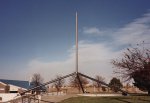 |
Amarillo |
Texas |
USA |
Obelisk or Vertical Gnomon |
Dial 67 |
| The Centennial Time Tower begins as a tetrahedron of stainless steel pipes each 18 feet long. Then a central pipe towers to the sky, giving an overall height of about 50 feet. The Time Tower is situated on a circle about 100 feet in diameter. The dial was erected for the hundredth anniversary of the discovery of Helium. Each individual pipe is a time capsule filled with helium. The plaque under the center of the tower shows when each one is to be opened. |
| |
| |
 |
Ambridge |
Pennsylvania |
USA |
Polyhedral Dial |
Dial 104 |
| In the garden of Old Economy Village is a 1964 reproduction of the historic 1825 original keep safety indoors. The 9-inch stone dial has four vertical dials on the E,W, N and S sides and one horizontal dial on top. The replica is in fair shape where the engraved hour lines are now severely weathered. The replica five iron gnomons are in fair condition, but still tell reasonably accurate local solar time. Each dial is delineated in half-hour marks with the hours shown in Arabic numbers. |
| |
| |
 |
Amherst |
Nova Scotia |
Canada |
Horizontal Dial |
Dial 472 |
| A Centennial Dial for Amherst, this is a square horizontal dial with clean design about 18 x 18 inches. The dial face and triangular gnomon are cast bronze sitting upon a granite pedestal. The dial has hour lines and Roman numerals from IIII (morning) to VIII (evening) and tick marks for the quarter hours. An accompanying display explains the function of the sundial and contains a table for the Equation of Time, including longitudinal correction. |
| |
| |
 |
Amherst |
Massachusetts |
USA |
Sun Alignment |
Dial 523 |
| On the fields of U-Mass is a work called "sunwheel" that is a modern presentation of an American Indian sun-wheel. A circle 130 feet in diameter has 14 major stones weighing 56 tons, 12 minor stones, and 4 flat stones at the center. 2 major stones mark the N and S cardinal points; a pair of portal stones mark the E and W points allowing an uninterrupted view of sunrise and sunset at the equinoxes; 4 stones mark sunrise and sunset at the solstices; and 4 more stones mark the extreme northern and southern positions of moon rise and moon set. Guided presentations can be arranged by calling 413-545-4311. |
| |
| |
 |
Anacortes |
Washington |
USA |
Vertical Dial |
Dial 212 |
| A vertical dial 4 x 8 feet on marine plywood painted the same color as the building. An aluminum rod gnomon casts the shadow, supported by a copper strut of plumbing pipe. Early photos show dial with no hour lines. By 2017, short hour and half hour lines added near the Arabic hour marks. Both form a semicircle around the gnomon, telling time from 7am to 6pm. |
| |
| |
 |
Anchorage |
Alaska |
USA |
Sculpture/Artwork |
Dial 999 |
| A sun sculpture called "Solar Path". The large 24 x 35 x 12 feet sculpture made by renowned artist Bill FitzGibbons consists of a blue vertical pole and two low sloping wedges. The vertical column makes a linear shadow that is supposed to show approximate solar time as it passes over evenly spaced inlaid hourly numbers from 8am to 8pm. This is not a functional sundial! The short wedge points to where the sunrises on the summer solstice and the longer wedge form points to where the sunrises on the winter solstice. |
| |
| |
 |
Andalusia |
Alabama |
USA |
Reflective Equatorial |
Dial 894 |
| This dial is one of Bill Gottesman's uniquely designed Renaissance dials of cast and structural bronze with a 27 inch diameter time telling helix whose axis is aligned to the celestial-north pole. Time is told by a focused beam of light from a long cylindrical unsilvered mirror situated on that N-S axis, reflecting sunlight into a slit of light onto the helix, telling time throughout the day. A sliding time scale within the helix is adjusted for longitude, date's equation of time correction and daylight saving time. Once this scale is adjusted for date, the dial shows civil (local clock) time with an accuracy of under one minute. The dial base is cast bronze that allows adjustment for latitude and is placed on a sandstone plinth. |
| |
| |
 |
Andover |
Massachusetts |
USA |
Armillary Sphere |
Dial 40 |
| A very large and ornate armillary sphere, approximately 8 feet in diameter. Sculpted by Paul Manship in 1928 and cast by Alexis Rudier Fondeur in Paris. The armillary has large figures inside the sphere at the base and the equatorial circle has signs of the zodiac in raised metalwork. The dial sits atop a well proportioned light granite pillar that is about 3 foot high and 4 foot diameter. |
| |
| |
 |
Ann Arbor |
Michigan |
USA |
Vertical Dial |
Dial 199 |
| A stone and bronze vertical dial approximately 10x6 feet just below the roof of the Mack School. Dial face includes Roman numerals showing Eastern Standard Time and a polar gnomon. Inscription appears below gnomon. |
| |
| |
 |
Ann Arbor |
Michigan |
USA |
Noon Mark or Meridian Dial |
Dial 1088 |
| Dial is a calendar dial that marks noon on the solstices and equinoxes by projecting a circle of sunlight onto one of three horizontal discs on the meridian line dial face. To create the round sunlight spots the vertical arm has three elliptical holes to match the solar angles for the two solstices and the equinox. The disk closest to the gnomon (with highest solar angle) is for the summer solstice. Middle disk is for the equinoxes, and the farthest disk (with lowest solar angle) is for the winter solstice. Notice in the photo that the summer hole in the vertical arm is considerably stretched to account for the high angle of the sun. |
| |
| |
 |
Ann Arbor |
Michigan |
USA |
Noon Mark or Meridian Dial |
Dial 1096 |
| Dial is a calendar dial that marks noon on the solstices and equinoxes by projecting a circle of sunlight onto one of three horizontal discs on the meridian line dial face. To create the round sunlight spots the vertical arm has three elliptical holes to match the solar angles for the two solstices and the equinox. The disk closest to the gnomon (with highest solar angle) is for the summer solstice. Middle disk is for the equinoxes, and the farthest disk (with lowest solar angle) is for the winter solstice. Notice in the photo that the summer hole in the vertical arm is considerably stretched to account for the high angle of the sun. |
| |
| |
 |
Ann Arbor |
Michigan |
USA |
Horizontal Dial |
Dial 616 |
| A 6 foot (1.8m) square weathering steel horizontal dial with a 3 foot (1m) high and 6 inch (15cm) wide steel gnomon in the shape of a simple triangle. Hour lines are welded steel strips, but without hour numerals. The dial is set on a steel wedge such that on sloping ground it brings the dial face horizontal. The noon gap is an artistically designed angular strip. The hour lines are offset from local, reflecting the 26 min advance from the central time zone meridian. Local mean noon (when the mean gnomon shadow falls in the noon gap) occurs at 12:26pm CST. A Plaque with the Equation of Time to convert shadow time into CST is being developed. |
| |
| |
 |
Ann Arbor |
Michigan |
USA |
Equatorial Dial |
Dial 617 |
| A three foot wide brass and steel armillary of complex design with many features. Gift of Albina du Bolsrouvray. Markings are in French. |
| |
| |
 |
Ann Arbor |
Michigan |
USA |
Vertical Dial |
Dial 618 |
| A painted steel on building brick vertical dial with a 6 foot gnomon. Gnomon includes decoration of two children and a gear wheel. Hour markings are Roman numerals. |
| |
| |
 |
Ann Arbor |
Michigan |
USA |
Horizontal Dial |
Dial 1087 |
| This horizontal brass dial is 16-inch (40.6cm) in diameter. A chapter ring holds hours marks in Roman numerals from 4am to 8pm, and includes 10 minute marks at the outer edge of the ring. The dial is plain with no inscription. The gnomon is broken off at the face of the dial. The dial is a placed on an irregular stone mount with two concrete blocks with the name Chubb and Sessions, whose family graves surround the sundial memorial. |
| |
| |
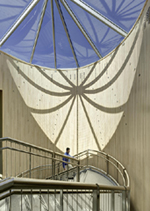 |
Ann Arbor |
Michigan |
USA |
Cylindrical Dial |
Dial 1085 |
| The dial is inscribed on a 20-ft (6m) diameter stairwell creating a very large cylindrical altitude sundial. The nodus is the center of the skylight directly above the circular stair well. Hours are marked at the top of the dial in Arabic numerals. Hour lines are a series of dots extending down the wall. A display near the dial explains how it functions. |
| |
| |
 |
Ann Arbor |
Michigan |
USA |
Horizontal Dial |
Dial 1084 |
| This is a large monumental scale horizontal sundial. The gnomon, approximately 15-ft (4.5m) high has a brass patina and made using polygonal segments assembled almost in jigsaw puzzle style to form a large triangle. The gnomon sits at the north end of a large 30-ft (9.1m) brick plaza, wasting the area of the plaza except for a large imbedded brass plaque. Hours are simply marked by light colored granite with a pointed exterior aimed toward the edge of the plaza. Harder to see are half-hour light colored small granite triangles. |
| |
| |
 |
Ann Arbor |
Michigan |
USA |
Equatorial Dial |
Dial 335 |
| Large equatorial dial, with gnomon in the shape of a treble clef sign. Approximately 4 foot across. Dedicated to founders of Sigma Alpha Iota international music fraternity for women. Dial sits atop a tapered cylinder 3 ft high. |
| |
| |
 |
Annapolis |
Maryland |
USA |
Armillary Sphere |
Dial 765 |
| A bronze armillary dial with meridian, horizon and equatorial rings on a concrete pedestal. Dial is located in Government House residence and requires a tour of the property for access. |
| |
| |
 |
Annapolis |
Maryland |
USA |
Horizontal Dial |
Dial 181 |
| Farenholt sundial for U.S. Naval Hospital Annapolis MD. This cast bronze dial was designed and commissioned by RADM Farenholt for U.S. Naval Hospitals at bases where he was commanding officer, visited, or had special meaning to him. The dial is 18 inches (46cm) in diameter. The outer chapter ring has the motto, followed by a chapter ring with Arabic hours 6am to 6pm, raised hour lines that radiate from near the foot of the gnomon and short half-hour lines. The gnomon has graceful curves and a trefoil or quatrefoil cut-out in the center. Below the gnomon is the naval command name, followed by the commissioning date in the southern portion of the hours chapter ring. |
| |
| |
 |
Annapolis |
Maryland |
USA |
Obelisk or Vertical Gnomon |
Dial 174 |
| 4'x4' Bronze & Brass 4' Dial plate is elaborately engraved bronze with hour and date lines. Self-orienting dial. Locate line for the date; rotate dial until shadow tip touches that line. Read time from intersection of the shadow's tip and the time line radiating from dial center. Gnomon is a model of a naval missile, resting on an anchor. A ship's binnacle supports rotating sundial plate. |
| |
| |
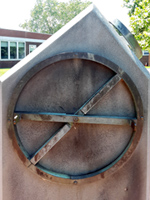 |
Annapolis |
Maryland |
USA |
Noon Mark or Meridian Dial |
Dial 1036 |
| This brass mariner's compass about 12 inches in diameter is mounted on the east side of a concrete pillar. It is known on campus as "The Ptolemy Stone". It functions as a meridian transit with altitude marks every half degree engraved on the upper south quadrant. The alidade has a notch on the upper end and a plate at the lower end, designed for measuring the altitude of the sun using the notch shadow (preventing eye damage of sighting the sun directly). The pillar is just over 3 feet tall with a sloped top. The main slope is that of the site latitude. A steeper "north face" is cut plane to the celestial equator. To make the equator "visible", a ring is mounted to the face. The ring casts no shadow on the equinox and from September to March is in shadow. A similar Ptolemy Stone is at St. John's campus in Santa Fe, NM. |
| |
| |
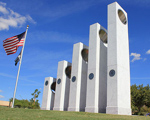 |
Anthem |
Arizona |
USA |
Sun Alignment |
Dial 821 |
| The Anthem Veterans Memorial in Anthem, AZ was dedicated on November 11, 2011 at 11am (11-11-11) to honor the service and sacrifice of the United States armed forces and to provide a place of honor and reflection for veterans, their family and friends. Veterans gather here annually on November 11th to watch a solar alignment at 11:11am when the sun precisely illuminates a 3-foot medallion of The Great Seal of the United States. |
| |
| |
 |
Arcata |
California |
USA |
Armillary Sphere |
Dial 192 |
| Armillary dial with horizon ring 4 ft. 4.5 in. diameter designed by Ken Lynch. Dial is made of brass and horizon ring has signs of the zodiac on it. Mounted at ground level with a separate plaque with Equation of Time. After the dial was installed the university ordered the point on the end of the gnomon sawed off. It was feared that someone might become impaled on it. Gift of Harvy S. Kieval, Professor Emeritus - Math. |
| |
| |
 |
Arvada |
Colorado |
USA |
Horizontal Dial |
Dial 22 |
| A large horizontal dial of brick and stone with a formed structural steel gnomon in the form of a modern sculpture. Roman numeral hour marks doe DST are on raised brick pillars. |
| |
| |
 |
Asheville |
North Carolina |
USA |
Analemmatic Dial |
Dial 731 |
| A 16 foot major axis analemmatic dial with stained concrete, hand painted date line. Hemlock branch hour posts were cut by Estate foresters and use iron numerals hand-forged by the Estate blacksmith. |
| |
| |
 |
Athens |
Ohio |
USA |
Horizontal Dial |
Dial 1009 |
| For a dial 114 years old, it is in excellent condition. The bronze dial is of simple form with hour marks every quarter of the hour and a chapter ring with Roman hours from 5:30am to 6:30pm. Surrounding the chapter ring it reads "Ohio University". Father time stands with a scythe at the foot of the gnomon that contains the profile of a bird. On the dial plate Shakespeare's Sonnet 16 is lightly engraved. The sundial was erected in 1907, though there is a photo of "a quartet of gentlemen" attributed in 1890, yet the cylindrical pedestal with plaque is easily recognizable. |
| |
| |
 |
Atlanta |
Georgia |
USA |
Equatorial Dial |
Dial 272 |
| This equatorial dial 1 meter in diameter. Made of iron, it has both an equatorial and meridian arc. There is an east-west thin vertical hoop that holds the arcs together. The sundial gnomon is an arrow held by the meridian arc and pointing to the north celestial pole. The dial rests on a triangular base that has the German eagle carved on all three sides. |
| |
| |
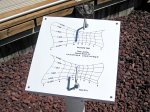 |
Atlantic Beach |
Florida |
USA |
Polar Dial |
Dial 732 |
| A 12 x 12 inch polar dial of printed plastic. Unlike the typical polar dial, this dial uses point-in-space or nodus gnomons. The dial face is aligned in the polar plane; separate face markings and gnomons show summer-to-winter and winter-to-summer hour and date lines corrected for EOT and longitude. Time and date are read from the shadow of only the tip end of each gnomon rod. The three foot high PVC dial support allows the face to be rotated about the polar axis; the face is pointed at the local meridian for ST and rotated 15? east to set for DST.
The face has hour lines for 8 AM to 4 PM and date lines for each month. The hour and date lines were designed for the dial location, median solar declination and the equation of time over a leap year cycle, atmospheric refraction and shadow shortening due to the 90? included angle conical gnomon points. The dial is accurate within two minutes. Dial face is marked with location, coordinates and designer name.
This dial is located within Fleet Landing, a gated retirement community. Please contact Russell Boyd, the dial owner/designer at 904-241-8544 to arrange visiting the dial. |
| |
| |
 |
Attleboro |
Massachusetts |
USA |
Vertical Dial |
Dial 917 |
| A 45 x 45 inch slate sundial hangs over the bay window. The dial is a vertical decliner with hour lines from 4am to 1pm. The gnomon has been damaged, but if you look carefully, there is a nodus and on the dial face are faint declination lines showing summer & winter solstices and the equinox. The hours are delineated on the hour and marked in Arabic numbers. |
| |
| |
 |
Auburn |
Maine |
USA |
Obelisk or Vertical Gnomon |
Dial 690 |
| A Vertical Gnomon Dial painted on an asphalt parking lot using the tip of a vertical light pole as the gnomon. Dial face includes hour lines, solstice and equinox lines and a compass rose showing true north direction. Markings include an analemma on the noon line with monthly marks. The dial is used as a teaching tool with formal lessons for students. The dial was designed using calculations from Naval Observatory. |
| |
| |
 |
Augusta |
Georgia |
USA |
Analemmatic Dial |
Dial 353 |
| An elegant analemmatic dial approximately 12 feet long laid in granite into the brick Riverwalk esplanade. The hours are Roman numerals set in an elliptical ribbon. The hour marks extend from 6am to 8pm and are offset for daylight saving time as well as a 28 minute longitude correction, The walkway is nicely marked, and at the base has the outline of two shoes and instructs "Stand on Date". |
| |
| |
 |
Augusta |
Maine |
USA |
Horizontal Dial |
Dial 872 |
| This historic brass dial is about 18 inches in diameter, set upon a square, concrete pillar. The dial plate has Roman numbers and is delineated in quarter hours. Magnetic variation is engraved at degree intervals. The dial originally had a removable wood cover, then a metal one, which became permanently closed. It was removed in 2009 and now has a plexiglass cover. From Betty Adams in the Kennebec Journal, "At the uncovering, a half dozen people strained to read some of the lettering on the dial: 'Arc for magnetic variation', [and on an interior circle] 'Moses B. Bliss - Circumferentor' which means surveyor's compass... The meridian monument was one of those erected at county courthouses in Maine between 1869 and 1871, according to research by Harold E. Nelson, senior geodesist at the Maine Department of Transportation's property office...Nelson said the monument would have been used by local land surveyors to test their compasses against true north." |
| |
| |
 |
Aurora |
Colorado |
USA |
Gnomonic or Projection Dial |
Dial 963 |
| The Sun Shell is a band shell made of a series of six stainless steel arcs creating the illusion of longitude lines on a globe tilted so the poles are on the east-west horizon. A nodus is placed on one of the arcs that casts a point of light onto the floor of the band shell plaza. The floor is marked with Arabic numerals and stainless steel hour lines from 10 am to 3 pm. |
| |
| |
 |
Aurora |
Colorado |
USA |
Equatorial Dial |
Dial 81 |
| A large Erickson Monument equatorial polar dial 6 feet in diameter made of light granite with a 3 inch steel rod as gnomon. The dial was dedicated as part of the bicentennial celebrations in July 1976. Hour lines from 4am to 8pm. Time is graduated by half-hour, quarter hours and 5 minute marks. Designed to be read from the upper surface in Spring/Summer, from the under side in Fall/Winter. A plaque provides the Equation of Time to convert solar time to watch time. Dial has both the bicentennial emblem and the city seal of the city of Aurora. |
| |
| |
 |
Bala Cynwyd |
Pennsylvania |
USA |
Vertical Dial |
Dial 1023 |
| This is a statuary of a saddened maiden leaning over a vertical dial. The hour lines are thick lines radiating from the foot of the gnomon from 5am to 5pm. The maiden's hand lays over the bronze gnomon. In the center of the dial is a compass rose. This may be an 18th century statuary, a cast copy of a dial and statue in London. |
| |
| |
 |
Baltimore |
Maryland |
USA |
Analemmatic Dial |
Dial 1015 |
| This red brick analemmatic is an ellipse 18x12 feet. It has concrete stone inlays for the zodiac walkway and hour stones from 5am to 7pm in black lettering. At the edges are markers for the cardinal points and along the east-west line are the seasonal points (Bailey Points) for determining the direction of the rise and set of the sun. |
| |
| |
 |
Baltimore |
Maryland |
USA |
Analemmatic Dial |
Dial 843 |
| Volunteers painted a 16 x 5 foot analemmatic dial for the elementary and middle school students. The dial has 8-inch circles for hour numbers from 5am to 7pm using standard time. The dial walkway is painted with yellow month lines and abbreviations for each month to the side. The words "summer" and "winter" are at the solstice lines. Bailey points are painted as small yellow circles to indicate the direction of sunrise and sunset from the observer's position on the walkway. |
| |
| |
 |
Baltimore |
Maryland |
USA |
Analemmatic Dial |
Dial 844 |
| Volunteers painted a 16 x 5 foot analemmatic dial for the elementary and middle school students. The dial has 8-inch circles for hour numbers from 5am to 7pm using standard time. The dial walkway is painted with yellow month lines and abbreviations for each month to the side. The words "summer" and "winter" are at the solstice lines. Bailey points are painted as small yellow circles to indicate the direction of sunrise and sunset from the observer's position on the walkway. |
| |
| |
 |
Baltimore |
Maryland |
USA |
Vertical Dial |
Dial 243 |
| 18 x29 inch vertical dial. Solar noon analemma, equinox and solstice lines, horizontal lines, line showing approx shadow lengths on April 15 and Aug 31. Lines sandblasted into veined white Carrera marble. Dial is calibrated for EDT. AM hours indicated by shadow of stile's western edge, PM, by shadow of its eastern edge. When shadow tip is bisected by appropriate seasonal segment of the line of the analemma, it is 1:06:35 PM. |
| |